Related Research Articles

Agrochola circellaris, The Brick, is a species of moth of the family Noctuidae. It is distributed throughout most of Europe, Asia Minor and Armenia.

Apamea remissa, the dusky brocade, is a species of moth of the family Noctuidae. It is distributed throughout Europe and Turkey, ranging across the Palearctic realm to Siberia, Manchuria and Japan. It has also been reported from Alaska.
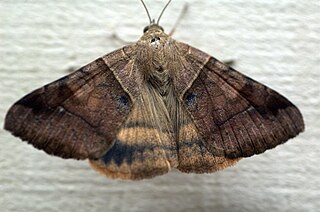
Mocis undata, the brown-striped semilooper, is a moth of the family Erebidae. The species was first described by Johan Christian Fabricius in 1775. It is found in the Afrotropical and Oriental regions, including India and Sri Lanka.

Capsula sparganii, or Webb's wainscot, is a moth of the family Noctuidae. The species was first described by Eugenius Johann Christoph Esper in 1790. It is found in Europe, Central Asia, from southern Siberia to Manchuria, Korea, Turkey, Syria and Iran.

Orthosia incerta, the clouded drab, is a species of moth of the family Noctuoidea. It is found in Europe. The occurrence of the species extends through all European countries through the Palearctic to the Russian Far East and Japan. It is absent from northern Fennoscandia. In the Alps it occurs up to 2000 m above sea level.

Mormo maura, the old lady or black underwing, is a moth of the family Noctuidae. The species was first described by Carl Linnaeus in his 1758 10th edition of Systema Naturae. It is found in the Palearctic realm, from north-western Africa through all over southern Europe. It reaches its northern border in the west in northern Ireland and central Scotland, in central Europe, in northern Germany and Poland. In some Nordic countries, there are single finds. The other occurrence areas include Turkestan, Anatolia, the Middle East and Iraq. The name "old lady" refers to the fact that the wing pattern was said to resemble the shawls worn by elderly Victorian ladies.
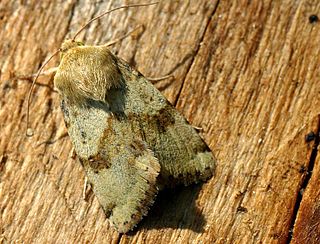
Heliothis viriplaca, the marbled clover, is a moth of the family Noctuoidea. It is found in Europe and across the Palearctic to Central Asia then to Japan, Korea and Sakhalin. In the south, it penetrates to Kashmir and Myanmar. As a migratory moth, it also reaches areas in northern Fennoscandia in some years. North of the Alps, both indigenous and immigrant individuals occur in certain areas. The heat-loving species occurs mainly on dry grasslands, fallow land, heathlands and sunny slopes and slopes and the edges of sand and gravel pits.

Caradrina clavipalpis, the pale mottled willow, is a moth of the family Noctuidae. The species was first described by Giovanni Antonio Scopoli in his 1763 Entomologia Carniolica. It is found in the Palearctic realm. It is an introduced species in North America, where it was first reported from Queens in New York City in 1993. In 2009 it was found in Rochester, New York, so it appears to be established and spreading.
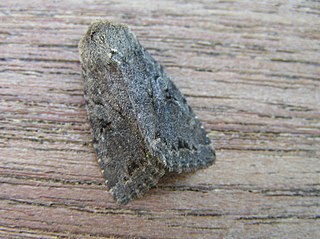
Fissipunctia ypsillon, the dingy shears, is a species of moth of the family Noctuidae. It is found in the Palearctic realm.
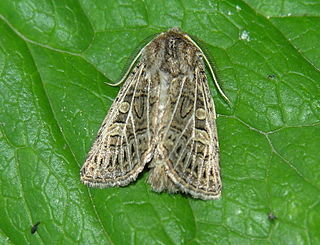
Tholera decimalis, the feathered Gothic, is a species of moth of the family Noctuidae. It is found in Europe and Scandinavia then through the Palearctic to Asia minor, western Central Asia, southern Siberia and in North Africa.
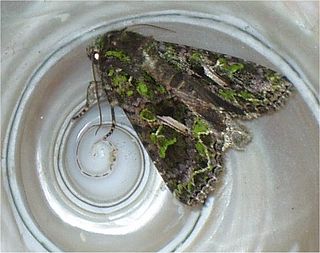
The Orache Moth(Trachea atriplicis) is a species of moth of the family Noctuidae. It is found in all of Europe, east across the Palearctic to the Pacific Ocean and Japan.

Spaelotis ravida, the stout dart, is a moth of the family Noctuidae. The species was first described by Michael Denis and Ignaz Schiffermüller in 1775. It is found in the Palearctic realm.

Apamea furva, the confused, is a moth of the family Noctuidae. The species was first described by Michael Denis and Ignaz Schiffermüller in 1775. It is found throughout Europe. In southwestern Europe it is primarily montane. It is found as far north as the Arctic Circle. From Europe its range extends to Siberia, Turkey, Iran, Kyrgyzstan, Mongolia and Xinjiang in China.

Athetis pallustris, the marsh moth, is a moth of the family Noctuidae. It is found in most of Europe, the southern Urals, southern Russia, Ukraine, eastern Turkey, Siberia, the Amur region, the Russian Far East, Mongolia and northern China.

Cochylis maiana, Kearfott's rolandylis moth, is a moth of the family Tortricidae. It is found in eastern North America, from Nova Scotia south to New Hampshire, Pennsylvania and New Jersey and North Carolina, but has also been recorded from southern France.
Agdistopis sinhala is a moth of the family Macropiratidae. It is found in south-east Asia, including Sri Lanka, India, Japan and Taiwan.
Scrobipalpopsis petrella is a moth in the family Gelechiidae. It was described by August Busck in 1915. It is found in North America, where it has been recorded from New Hampshire, Illinois, Maine and Alberta.
Scrobipalpopsis tetradymiella is a moth in the family Gelechiidae. It was described by August Busck in 1903. It is found in North America, where it has been recorded from California, Arizona and Nevada.
Symmetrischema pallidochrella is a moth in the family Gelechiidae. It was described by Vactor Tousey Chambers in 1872 and is found in North America.
Martyringa xeraula, the Himalayan grain moth, is a moth in the family Lecithoceridae. It was described by Edward Meyrick in 1910. It is found in India (Assam), western China, Japan and North America, where it has been recorded from Louisiana, Texas and from Florida to South Carolina.
References
- ↑ Savela, Markku. "Scrobipalpopsis Povolný, 1967". Lepidoptera and Some Other Life Forms. Retrieved November 4, 2017.
- ↑ Moth Photographers Group. Mississippi State University.
- ↑ Proceedings of the United States National Museum 92 (3149): 268
| This article on a moth of the tribe Gnorimoschemini is a stub. You can help Wikipedia by expanding it. |